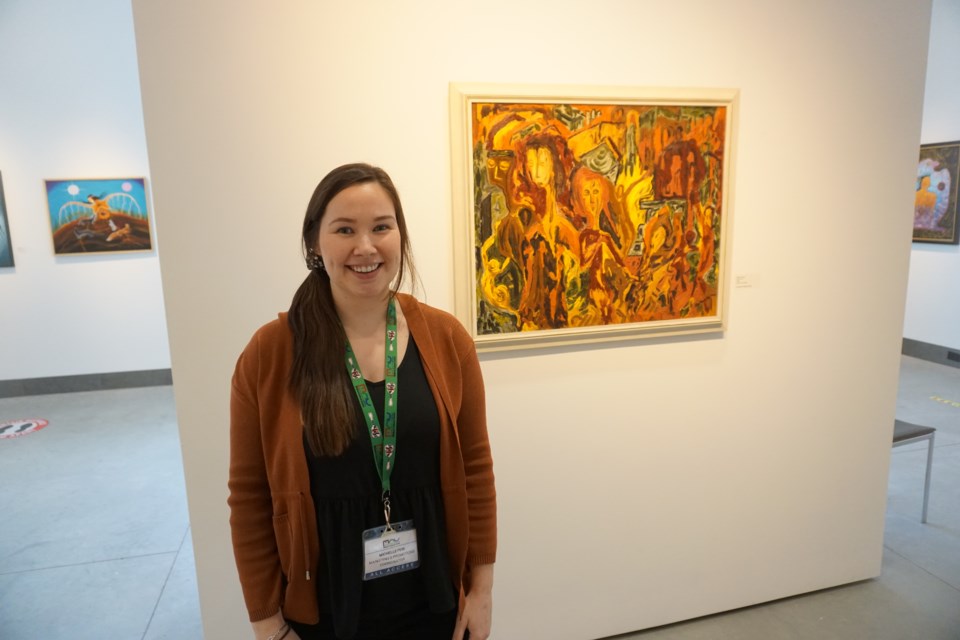Most Canadians likely know at least a little bit about the famed Canadian painting group known as the Group of Seven.
But their art knowledge likely dwindles when they’re told about the ‘Indigenous Group of Seven’.
And that’s something the Midland Cultural Centre hopes to change with an exhibition that opened Friday featuring this group of seven artists, who curator Patricia Monague says created the styles and interpretations many of today’s Indigenous artists have adapted into their work.
“This is a chance for Indigenous artists to see what the earlier artists were doing,” Monague said.
This Group of Seven was a ground-breaking cultural and political entity that self-organized in the early 1970s to demand recognition as professional, contemporary artists and stimulated a new way of thinking about First Nations people and their art.
The exhibition, which runs until April 22 in the MCC’s main level gallery, focuses on the work of Jackson Beardy, Eddy Cobiness, Alex Janvier, Norval Morrisseau, Daphne Odjig, Carl Ray and Joseph Sanchez.
“These pieces are true examples of how Indigenous spirituality is interpreted by the artist,” Monague says, who’s a Beausoleil First Nation member and serves as Chimnissing's heritage and culture coordinator.
“These artists have given us another way to visualize our spirit language, our stories, our teachings with the swirl of a paint brush.”
Monague says she got emotional after originally selecting the paintings for the exhibition because of the “ancestral connections” they serve to Indigenous peoples.
“For us, these are the originals,” Monague says. “I remember being totally blown away. It’s important that we always connect with our past. We can’t take any steps ahead unless we know where we come from.”
Past MCC chair John Hartman, who is assisting Monague with the exhibition, says the main-floor gallery became available a couple of years ago.
“The MCC made a decision that we would like to have an Indigenous gallery,” Hartman says, noting the space is open to Beausoleil First Nation artists and other Indigenous groups to exhibit their work based on the recommendations of an Indigenous advisory committee.
“It’s exclusively for Indigenous artists,” Hartman says, pointing out the first exhibition in 2021 featured the work of local artist Andy Trudeau.
“There will be four exhibits for 2023 that will all be curated by Patricia Monague. She was very excited about this exhibition because she remembers how difficult it was for (Indigenous) artists.”
And while non-Indigenous artists are shut out of showing their work in the gallery, Hartman points out Quest still has two galleries on the second level.
“The MCC has really wanted to make the centre a place where local Indigenous people felt it was a place for them,” he adds.
As for the creation of the ‘Indigenous Group of Seven,’ it all started in Odjig’s printshop and gallery, which by 1971, had become a gathering place in Winnipeg for spirited artistic and political discussion.
She, along with Beardy, Cobiness and Sanchez regularly met to talk about their professional aspirations, their experiences as “outsiders” in the Canadian gallery establishment and their encounters with institutional barriers,” according to an MCC release.
They invited other Indigenous artists across the country to join in the quest for self-determination and professional advancement and three artists, Janvier from Alberta along with Ray and Morrisseau from Ontario, responded to the call.
“The objectives of the group were based on a shared concern with Indigenous philosophies, worldviews, and aesthetics – the work they produced represents a new, innovative language of art,” the release further notes.
“Their paintings communicate a connection to a dynamic culture with subject matter that is often personal, humorous, spiritual and political. Still other works turn to legends, oral traditions, and the supernatural to articulate spiritual beliefs.
“The work of these pivotal artists led to the development and acceptance of an Indigenous art discourse and the recognition of Indigenous artists as a vital part of Canada’s past, present and future identity.”
